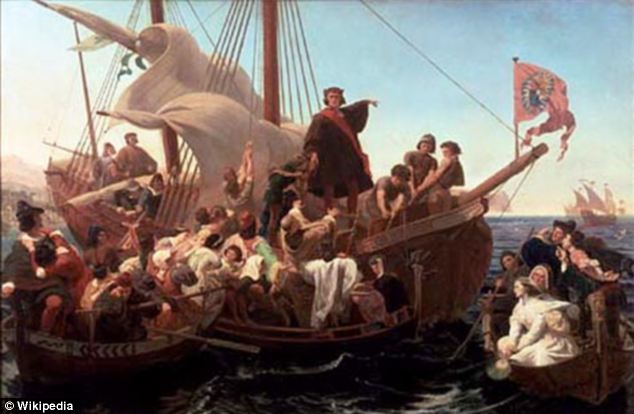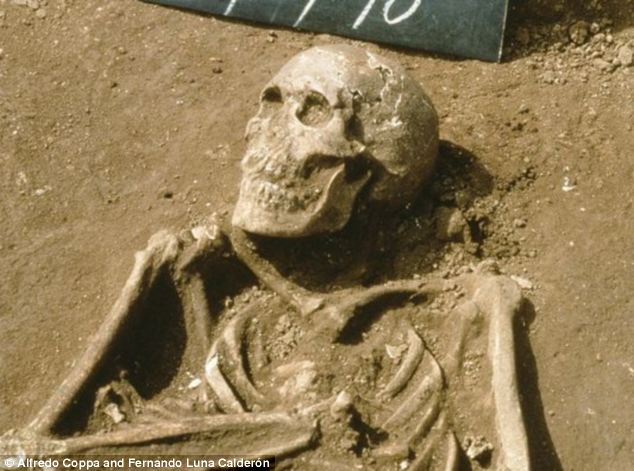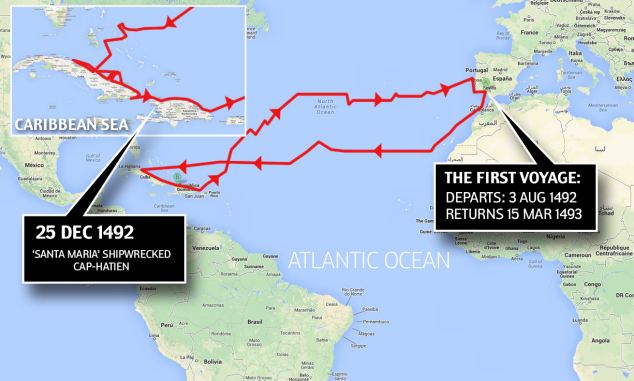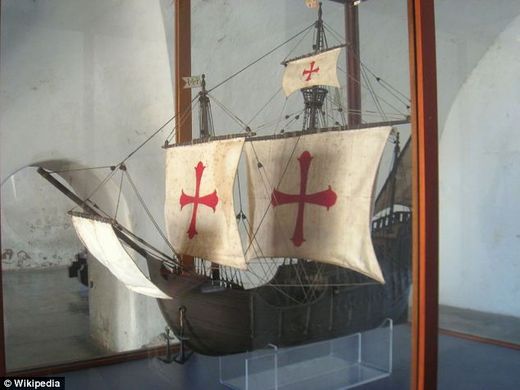
Portuguese-American historian, Manuel Rosa has spent 20 years tracing the ship.He believes the Santa Maria was purposely dragged up onto the beach of Caracol, re-christened Natividad and ordered shot side-to-side by a cannonball on January 2, 1493.
'This cannonball intentionally disabled and marooned the Santa Maria,' claims Rosa.
He believes Columbus had to maroon the Santa Maria for three reasons: So that those left behind could not follow him home, so that Spain was forced to send a rescue fleet, and because the Santa Maria would have been highly dangerous to sail back through the winter seas of the Azores.
The Santa MariaHe also claims in the book Columbus-The Untold Story, which is currently looking for an English language publisher, the explorer made sure to take back all the pilots with him, so that, if those marooned could repair the hole in the ship's hull, they would not know how to reach Spain.
The Santa María was believed to be a 58 ft (17.7 m) long boat, described as 'very little larger than 100 toneladas' (About 100 tons, or tuns).
It was used as the flagship for the expedition, along with the smaller ships Santa Clara, remembered as La Niña ('The Girl'), and La Pinta ('The Painted').
All three of the ships were second-hand (if not third or more) and were not intended for exploration.
'All of Columbus's actions were calculated to prevent scrutiny, hide his tracks and allow for Portugal to control the spice trade of India, while denying Spain access to that same route' Rosa said.
'By marooning his own ship, Columbus was free to report to the court of Queen Isabella whatever lies he wanted without the court's overseers from the 1492 voyage contradicting him, exactly as he did.'
He says recent claims that the ship had been found are absurd.
'Anyone looking for the Santa Maria in the ocean has not fully understood Columbus's Ship Log, nor the ruse he was taking part in, and is wasting their time since the ship was left on land and was later burned to ashes by the natives,'
However, a recent expedition has left experts 'confident' a wreck found off the north coast of Haiti is the the Santa Maria.
The wreck was found off the north coast of Haiti during an expedition led by Barry Clifford, an explorer most famously known for his discovery of a complete pirate ship.
'All the geographical, underwater topography and archaeological evidence strongly suggest that this wreck is Columbus famous flagship, the Santa Maria,' said Clifford, who led a recent expedition to the wreck as part of a History Channel TV show.
'The Haitian government has been extremely helpful and we now need to continue working with them to carry out a detailed archaeological excavation', he told the Independent.
Clifford has spent over a decade tracing the origins of the wreck.
During The first voyage of Columbus in 1492, near Hispaniola, Columbus' flagship, the Santa María ran aground, and the waves smashed it to pieces.
Leaving several men behind to establish a fort, Columbus set sail for Spain in the Niña.
The discovery has been backed up by 2003 researcher that pinpointed the probable location of Columbus's fort nearby.
An expedition a decade ago led by Clifford had photographed the wreck - but had no idea the boat was the Santa Maria.
However, the team has already found items - including a cannon, have been looted, and is working with the Haitian government 'to ensure the site is protected and preserved.
'I am confident that a full excavation of the wreck will yield the first ever detailed marine archaeological evidence of Columbus's discovery of America, said Clifford.
'If excavations go well, it may ultimately be possible to lift any surviving remains of the vessel, fully conserve them and put them on display in a museum in Haiti.
The First Voyage of ColumbusPrevious researcher has found the daring seafarers who went on Christopher Columbus' second trip to the New World in 1493 had major obstacles to overcome in their journey.
In 1492, King Ferdinand and Queen Isabella, the rulers of the Spanish kingdoms of Castile and Aragon, agreed to outfit three ships for Columbus, also promising to make him governor of any new lands he might acquire, along with 10 percent of all the wealth that he would bring to Spain.
With his fleet of three ships Columbus sailed west on August 3, 1492 with 90 crew, first stopping at the Canary Islands to make repairs and take aboard fresh food.
Then the fleet headed out into the open Atlantic, dubbed the Sea of Darkness
On the 70th day (many days after Columbus had already expected to reach Japan), a lookout sighted land.
It was early on the morning of October 12, 1492. They landed on one of the islands of the Bahamas, which Columbus named San Salvador.
The island natives came down to the shore to see Columbus' strange ships. Thinking he had reached the East Indies, Columbus called these people Indians.
Columbus had discovered what Europeans would soon call the New World of the Americas.
Santa María ship model displayed in Fort San Cristóbal, San Juan, Puerto Rico
The voyage sailed on to Asia.
He spent the next ten weeks exploring the islands of the Caribbean, landing on the island of Hispaniola, shared today by the Dominican Republic and Haiti.
He also landed on Cuba, which he thought was the Asian mainland.
Both islands were heavily populated.
Near Hispaniola, Columbus' flagship, the Santa María, ran aground.
The waves smashed it to pieces.
Leaving several men behind to establish a fort, Columbus set sail for Spain in the Niña.
On the voyage home, he wrote a report of his discoveries.
He offered 'as much gold as they need...and as many slaves as they ask' if King Ferdinand and Queen Isabella would finance another voyage.
As proof of what he could do, he brought them back a small amount of gold, parrots, and plants - as well as some Indians he had kidnapped and enslaved.
Not only were they stepping into the unknown to find a home, but a new study suggests they may have also suffered from scurvy while sailing across the Atlantic.
The scurvy killed many of the early colonisers, researchers claim, causing the ultimate demise of the La Isabela settlement within just four years of it being founded.
This is according to historic documents and analysis of 27 skeletons buried at Columbus' settlement in what is now the Dominican Republic.
Researchers believe the colonisers beat most of the scurvy by the time they died, but the disease may have contributed to a wave of deaths in the early colony.
La Isabela, the first permanent European town in the Western Hemisphere, was abandoned within just four years of being established amid sickness and deprivation.
Bones of sailors and colonists from graves behind the abandoned village's small churchyard have been unearthed from the site since the 1980s.
La Isabela was established in what is now the Puerto Plata, Dominican Republic. It was one of the first European settlements in America.
It was founded by Christopher Columbus during his second voyage in 1493 and named after Queen Isabella I of Castile.

A group of settlers, led by Bernal de Pisa, attempted to capture and make off with several ships and go back to Spain.
La Isabela's demise took place in 1496 when Columbus decided to abandon it in favour of a new settlement, which is now known as Santo Domingo.
'They were still encased in earth when we started the study. We had to clean the bones to proceed,' study author Vera Tiesler told National Geographic.
Historians have blamed smallpox, influenza, and malaria for the town's failure, but the latest study by Mexico's Universidad Autonoma de Yucatán argues scurvy was the main cause.
At least 20 of the 27 skeletons had signs - ridges carved in the outer lining of bones - of what the study describes as 'severe scurvy.'
Scurvy, caused by one to three months of vitamin C deficiency, plagued seafarers until the 18th century. Symptoms included lethargy, anaemia, and, the re-opening of old wounds.
Researchers suggest the voyagers might have avoided scurvy if they'd sailed directly from Spain to La Isabela - a journey of two months or less.
When Columbus and his companions reached the Americas, they landed at a Hispaniola outpost first.
'It was especially long, this trip - three months. And that's exactly the time scurvy needs to be in full bloom,' Professor Tiesler said.





Comment: Columbus Day? True Legacy: Cruelty and Slavery